The global beeswax for cosmetics industry is valued at USD 339.0 million in 2025 and projected to expand to USD 599.7 million by 2035, recording an absolute increase of USD 256.7 million at a CAGR of 5.8%. Supply-side dynamics play a central role in shaping this trajectory, as raw material sourcing, processing capacity, and distribution models determine how consistently cosmetic producers can access high-quality beeswax through the horizon ending 2035.
Production of beeswax remains heavily dependent on beekeeping activity, making supply directly tied to honey production cycles and bee population health. Countries with large-scale apiculture, such as China, India, Turkey, Ethiopia, and parts of the European Union, dominate raw material availability. However, bee population stress caused by habitat degradation, pesticide exposure, and disease outbreaks introduces volatility in yield. This volatility can affect global pricing, as cosmetic-grade beeswax requires consistent quality standards that limit substitution from lower-grade industrial waxes. Supply-side pressure is therefore expected to remain a defining constraint through the period ending 2030.
Processing capacity also shapes supply dynamics. Raw beeswax collected from honeycombs undergoes filtration, purification, and refining to meet cosmetic standards. Specialized refiners in Europe and Asia supply global cosmetic manufacturers, offering different grades depending on purity and melting points. Supply is constrained not just by raw wax availability but also by the capacity of refiners to deliver certified, contaminant-free batches in line with cosmetic safety regulations. This creates concentration risk, as fewer refiners dominate higher-value cosmetic-grade supply chains. Expansion of refining capacity and certification programs is likely to become a focus during the years ending 2035.
Trade patterns further influence supply availability. Beeswax is globally traded, with large exporters including China, Ethiopia, and Argentina, while import-dependent markets such as the United States and Europe rely on steady inflows for their cosmetics industries. Tariff and non-tariff regulations, organic certifications, and quality assurance standards determine how easily exporters can access these regions. Certification barriers can slow supply entry, particularly in regulated cosmetics hubs like the EU, reinforcing the advantage of suppliers with advanced traceability systems. Competition from synthetic and plant-based waxes also indirectly influences beeswax supply. While substitutes do not fully replicate the emollient and stabilizing properties of natural beeswax, they reduce the pressure on raw material scarcity by offering alternatives for certain formulations.
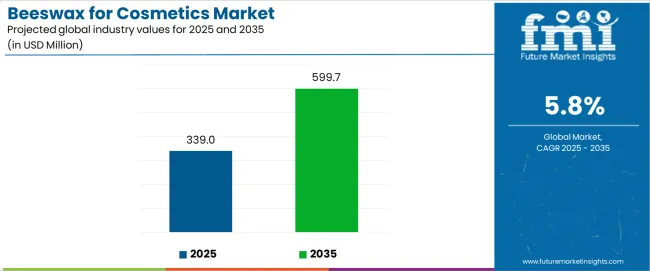
Between 2025 and 2030, the beeswax for cosmetics market is projected to expand from USD 339.0 million to USD 448.2 million, resulting in a value increase of USD 109.2 million, which represents 42.6% of the total forecast growth for the decade. This phase of development will be shaped by increasing demand for clean beauty ingredients, rising consumer preference for natural formulation components, and growing availability of certified organic beeswax across commercial cosmetic manufacturing and specialty product development facilities.
Between 2030 and 2035, the beeswax for cosmetics market is forecast to grow from USD 448.2 million to USD 595.7 million, adding another USD 147.5 million, which constitutes 57.4% of the ten-year expansion. This period is expected to be characterized by the advancement of premium-grade beeswax varieties, the integration of refined processing technologies for quality enhancement, and the development of specialized application formats across diverse cosmetic categories. The growing emphasis on natural ingredient sourcing and ethical production practices will drive demand for premium beeswax varieties with enhanced purity characteristics, improved functional properties, and superior performance attributes.
| Metric | Value |
|---|---|
| Estimated Value in (2025E) | USD 339.0 million |
| Forecast Value in (2035F) | USD 599.7 million |
| Forecast CAGR (2025 to 2035) | 5.8% |
The cosmetic ingredients market is the primary contributor, accounting for approximately 30-35%. Beeswax is widely used as a natural emulsifier, thickening agent, and moisturizer in a variety of cosmetic products such as creams, lotions, balms, and lipsticks, owing to its skin-nourishing properties and hypoallergenic nature. The personal care and beauty products market holds around 25-30%, as consumers increasingly seek natural and organic ingredients in their beauty products, boosting the demand for beeswax as a safer and eco-friendly alternative to synthetic compounds.
The natural and organic cosmetics market is another significant contributor, representing about 15-18%. As demand for organic and clean beauty products rises, beeswax serves as a preferred ingredient due to its natural origin, non-toxic properties, and ability to provide hydration and texture without harmful chemicals. The pharmaceuticals and wellness market contributes approximately 10-12%, with beeswax used in topical ointments, balms, and healing creams for its soothing and protective qualities. The home and DIY beauty market holds about 8-10%, as beeswax is increasingly used in homemade cosmetic formulations, such as lip balms and lotions, by consumers looking for cost-effective, natural alternatives for personal care.
Market expansion is being supported by the increasing global demand for natural cosmetic ingredients and the corresponding shift toward clean beauty formulations that can provide superior texture characteristics while meeting consumer requirements for ingredient transparency and environmentally conscious production processes. Modern cosmetic manufacturers are increasingly focused on incorporating natural materials that can enhance product performance while satisfying demands for authentic, premium-positioning ingredients and optimized formulation practices. Beeswax's proven ability to deliver emulsifying properties, moisture retention, and diverse application possibilities makes it essential for beauty brands and quality-conscious cosmetic manufacturers.
The growing emphasis on premium formulation and product differentiation is driving demand for high-quality beeswax systems that can support distinctive texture enhancement and comprehensive brand positioning across lip care, skincare, and color cosmetic categories. Consumer preference for ingredients that combine functional excellence with natural origin is creating opportunities for innovative implementations in both traditional and emerging cosmetic applications. The rising influence of clean beauty trends and natural ingredient awareness is also contributing to increased adoption of beeswax that can provide authentic performance benefits and reliable formulation characteristics.
The beeswax for cosmetics market is segmented by product type, application, processing method, end-use category, and region. By product type, the market is divided into natural beeswax, synthetic beeswax, and refined beeswax. Based on application, the market is categorized into lipstick, lip balm, cream, foundation, and others. By processing method, the market includes crude processing, refined processing, and specialty processing. By end-use category, the market encompasses luxury cosmetics, mass market cosmetics, organic cosmetics, and professional cosmetics. Regionally, the market is divided into North America, Europe, Asia Pacific, Latin America, the Middle East & Africa, and other regions.
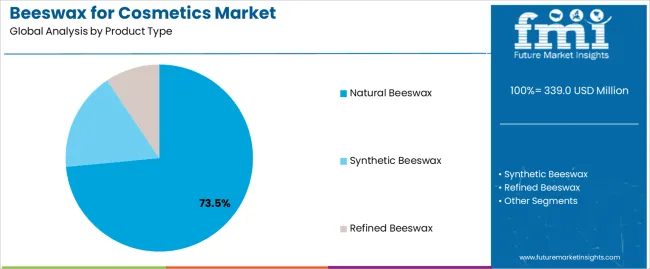
The natural beeswax segment is projected to account for 73.5% of the beeswax for cosmetics market in 2025, reaffirming its position as the leading product category. Beauty manufacturers and cosmetic formulators increasingly utilize natural beeswax for its superior authenticity characteristics, established consumer acceptance, and essential functionality in diverse formulation applications across multiple product categories. Natural beeswax's proven ingredient integrity and consumer-preferred positioning directly address formulator requirements for clean beauty compliance and optimal ingredient value in premium applications.
This product segment forms the foundation of modern cosmetic formulation patterns, as it represents the ingredient with the greatest consumer appeal potential and established compatibility across multiple cosmetic systems. Brand investments in natural ingredient sourcing and quality verification continue to strengthen adoption among quality-conscious manufacturers. With consumers prioritizing ingredient transparency and natural origin, natural beeswax aligns with both market trends and performance requirements, making it the central component of comprehensive clean beauty strategies.
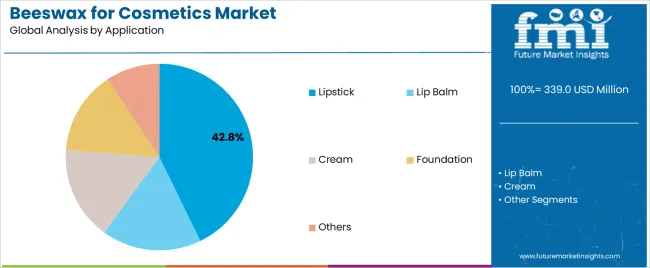
Lipstick is projected to represent 42.8% of the beeswax for cosmetics market in 2025, underscoring its critical role as the primary application for quality-focused brands seeking superior texture enhancement benefits and enhanced product performance credentials. Cosmetic manufacturers and beauty brands prefer lipstick applications for their established formulation patterns, proven market acceptance, and ability to maintain exceptional wear properties while supporting versatile color offerings during diverse consumer experiences. Positioned as essential applications for discerning formulators, lipstick offerings provide both performance excellence and brand positioning advantages.
The segment is supported by continuous improvement in color cosmetic technology and the widespread availability of established formulation frameworks that enable premium positioning and superior wear characteristics at the consumer level. Cosmetic companies are optimizing formulation designs to support market differentiation and accessible pricing strategies. As color cosmetic technology continues to advance and consumers seek long-wearing lip products, lipstick applications will continue to drive market growth while supporting brand recognition and consumer satisfaction strategies.
The beeswax for cosmetics market is advancing rapidly due to increasing clean beauty consciousness and growing need for natural ingredient choices that emphasize superior formulation performance outcomes across skincare segments and color cosmetic applications. The beeswax for cosmetics market faces challenges, including supply chain limitations from bee colony health concerns, price volatility affecting production economics, and competition from synthetic alternatives. Innovation in processing standardization and advanced purification systems continues to influence market development and expansion patterns.
The growing adoption of beeswax in luxury skincare and premium beauty formulations is enabling brands to develop product lines that provide distinctive moisturizing benefits while commanding premium positioning and enhanced sensory characteristics. Luxury applications provide superior emollient properties while allowing more sophisticated texture enhancement across various product categories. Formulators are increasingly recognizing the functional advantages of beeswax positioning for premium ingredient authentication and quality-conscious formulation integration.
Modern beeswax suppliers are incorporating advanced traceability technologies, ethical sourcing practices, and transparent supply chain systems to enhance ingredient credentials, improve quality assurance outcomes, and meet commercial demands for responsible ingredient procurement. These systems improve ingredient authenticity while enabling new applications, including organic certification and source verification programs. Advanced traceability integration also allows suppliers to support quality leadership positioning and regulatory compliance beyond traditional ingredient operations.
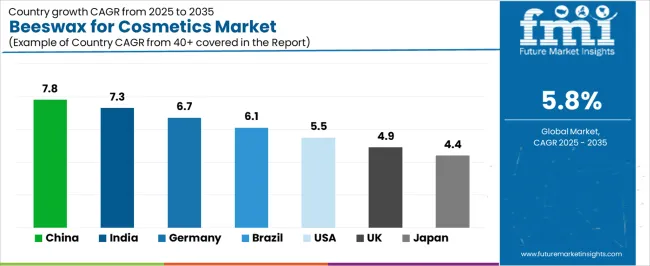
| Country | CAGR (2025 to 2035) |
|---|---|
| China | 7.8% |
| India | 7.3% |
| Germany | 6.7% |
| Brazil | 6.1% |
| USA | 5.5% |
| UK | 4.9% |
| Japan | 4.4% |
The beeswax for cosmetics market is experiencing robust growth globally, with China leading at a 7.8% CAGR through 2035, driven by the expanding beauty industry, growing consumer preference for natural ingredients, and increasing adoption of premium cosmetic formulations. India follows at 7.3%, supported by rising beauty consciousness, expanding middle-class demographics, and growing acceptance of natural beauty solutions. Germany shows growth at 6.7%, emphasizing established cosmetic manufacturing capabilities and comprehensive ingredient development. Brazil records 6.1%, focusing on natural ingredient sourcing and beauty market expansion. The USA demonstrates 5.5% growth, prioritizing clean beauty innovation and premium formulation development. The UK shows 4.9% growth, supported by natural beauty trends and quality ingredient demand. Japan demonstrates 4.4% growth, prioritizing premium cosmetic solutions and technological advancement.
The report covers an in-depth analysis of 40+ countries, with top-performing countries highlighted below.
Revenue from beeswax for cosmetics consumption and sales in China is projected to exhibit exceptional growth with a CAGR of 7.8% through 2035, driven by the country's rapidly expanding beauty sector, favorable consumer attitudes toward natural ingredients, and initiatives promoting premium cosmetic development across major manufacturing regions. China's position as a leading beauty market and increasing focus on clean beauty formulation are creating substantial demand for high-quality beeswax in both commercial and specialty markets. Major cosmetic brands and beauty manufacturers are establishing comprehensive ingredient sourcing capabilities to serve growing demand and emerging market opportunities.
Demand for beeswax for cosmetics products in India is expanding at a CAGR of 7.3%, supported by rising beauty awareness, growing natural ingredient preference, and expanding cosmetic manufacturing infrastructure. The country's developing beauty capabilities and increasing commercial investment in premium formulation are driving demand for beeswax across both traditional and modern cosmetic applications. International beauty companies and domestic manufacturers are establishing comprehensive operational networks to address growing market demand for quality beeswax and natural ingredient solutions.
Revenue from beeswax for cosmetics products in Germany is growing at a CAGR of 6.7% through 2035, supported by the country's established cosmetic industry, advanced manufacturing culture, and leadership in ingredient quality standards. Germany's sophisticated supply chain infrastructure and strong support for natural ingredients are creating steady demand for both traditional and innovative beeswax varieties. Leading cosmetic brands and specialty manufacturers are establishing comprehensive operational strategies to serve both domestic markets and growing export opportunities.
Demand for beeswax for cosmetics products in Brazil is projected to expand at a CAGR of 6.1% through 2035, driven by the country's emphasis on natural beauty traditions, expanding cosmetic industry, and sophisticated ingredient sourcing capabilities for formulations requiring specialized natural varieties. Brazilian manufacturers and beauty brands consistently seek commercial-grade ingredients that enhance product differentiation and support retail operations for both traditional and innovative cosmetic applications. The country's position as a Latin American beauty leader continues to drive innovation in specialty beeswax applications and commercial ingredient standards.
Revenue from beeswax for cosmetics products in the USA is anticipated to grow at a CAGR of 5.5% through 2035, supported by the country's emphasis on clean beauty trends, advanced formulation technology, and premium ingredient requirements for innovative cosmetic solutions. American beauty brands and cosmetic manufacturers prioritize ingredient transparency and natural positioning, making beeswax essential for both traditional and modern formulation applications. The country's comprehensive innovation excellence and advancing beauty patterns support continued market expansion.
Demand for beeswax for cosmetics products in the UK is expected to expand at a CAGR of 4.9% through 2035, supported by the country's mature beauty market, established natural ingredient culture, and comprehensive quality requirements. British beauty brands and cosmetic manufacturers prioritize ingredient heritage and premium positioning, creating steady demand for high-quality beeswax across diverse cosmetic applications. The country's sophisticated retail infrastructure and consumer awareness support continued market development.
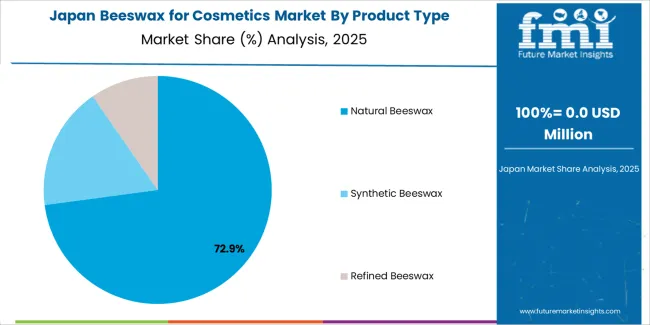
Revenue from beeswax for cosmetics products in Japan is projected to grow at a CAGR of 4.4% through 2035, supported by the country's emphasis on beauty innovation, cosmetic precision, and advanced ingredient technology requiring efficient natural solutions. Japanese beauty brands and cosmetic manufacturers prioritize ingredient performance and formulation excellence, making beeswax important for both traditional and modern cosmetic applications. The country's comprehensive quality excellence and advancing beauty patterns support continued market stability.
The Europe beeswax for cosmetics market is projected to grow from USD 102.7 million in 2025 to USD 178.2 million by 2035, recording a CAGR of 5.7% over the forecast period. Germany leads the region with a 35.8% share in 2025, moderating slightly to 35.2% by 2035, supported by its strong cosmetic manufacturing base and demand for premium, natural ingredient solutions.
The United Kingdom follows with 18.9% in 2025, easing to 18.4% by 2035, driven by sophisticated beauty market and emphasis on natural ingredient sourcing and quality standards. France accounts for 16.7% in 2025, rising to 17.1% by 2035, reflecting steady adoption of luxury cosmetic formulations and premium beauty innovation.
Italy holds 12.3% in 2025, expanding to 12.8% by 2035 as natural cosmetic trends and specialty beauty applications grow. Spain contributes 8.9% in 2025, growing to 9.2% by 2035, supported by expanding beauty sector and natural ingredient adoption. The Nordic countries rise from 4.8% in 2025 to 5.1% by 2035 on the back of strong natural beauty trends and advanced cosmetic technologies. BENELUX remains at 2.6% share across both 2025 and 2035, reflecting mature, quality-focused beauty markets.
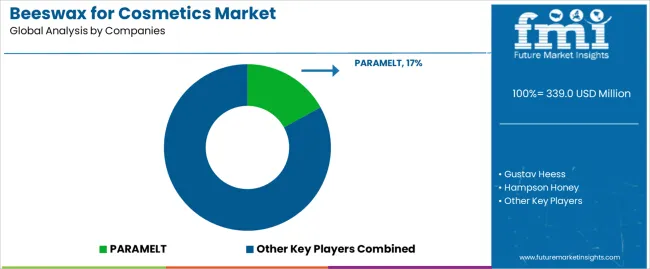
The beeswax for cosmetics market is characterized by competition among established ingredient suppliers, specialized natural product companies, and integrated cosmetic material solution providers. Companies are investing in purification technologies, advanced processing systems, product quality capabilities, and comprehensive distribution networks to deliver consistent, high-quality, and reliable beeswax ingredients. Innovation in grade enhancement, purity standardization methods, and application-specific product development is central to strengthening market position and customer satisfaction.
PARAMELT leads the beeswax for cosmetics market with a strong focus on natural ingredient innovation and comprehensive beeswax solutions, offering commercial ingredient systems with emphasis on processing excellence and quality heritage. Gustav Heess provides specialized natural ingredient capabilities with a focus on European market applications and material engineering networks. Hampson Honey delivers integrated beekeeping solutions with a focus on quality positioning and operational excellence. Poth Hille specializes in comprehensive natural wax manufacturing with an emphasis on cosmetic applications. CERARICA NODA Co., Ltd. focuses on comprehensive Asian market solutions with advanced processing and premium positioning capabilities.
The success of beeswax for cosmetics in meeting commercial formulation demands, consumer-driven natural ingredient requirements, and performance integration will not only enhance beauty product outcomes but also strengthen global cosmetic ingredient manufacturing capabilities. It will consolidate emerging regions' positions as hubs for efficient natural ingredient production and align advanced economies with premium cosmetic ingredient systems. This calls for a concerted effort by all stakeholders - governments, industry bodies, manufacturers, distributors, and investors. Each can be a crucial enabler in preparing the beeswax for cosmetics market for its next phase of growth.
| Items | Values |
|---|---|
| Quantitative Units (2025) | USD 339.0 million |
| Product Type | Natural Beeswax, Synthetic Beeswax, Refined Beeswax |
| Application | Lipstick, Lip Balm, Cream, Foundation, Others |
| Processing Method | Crude Processing, Refined Processing, Specialty Processing |
| End-Use Category | Luxury Cosmetics, Mass Market Cosmetics, Organic Cosmetics, Professional Cosmetics |
| Regions Covered | North America, Europe, Asia Pacific, Latin America, Middle East & Africa, Other Regions |
| Countries Covered | China, India, Germany, Brazil, United States, United Kingdom, Japan, and 40+ countries |
| Key Companies Profiled | PARAMELT, Gustav Heess, Hampson Honey, Poth Hille, CERARICA NODA Co., Ltd., and other leading beeswax companies |
| Additional Attributes | Dollar sales by product type, application, processing method, end-use category, and region; regional demand trends, competitive landscape, technological advancements in purification engineering, quality enhancement initiatives, natural sourcing programs, and premium ingredient development strategies |
The global beeswax for cosmetics market is estimated to be valued at USD 339.0 million in 2025.
The market size for the beeswax for cosmetics market is projected to reach USD 599.7 million by 2035.
The beeswax for cosmetics market is expected to grow at a 5.8% CAGR between 2025 and 2035.
The key product types in beeswax for cosmetics market are natural beeswax , synthetic beeswax and refined beeswax.
In terms of application, lipstick segment to command 42.8% share in the beeswax for cosmetics market in 2025.






Full Research Suite comprises of:
Market outlook & trends analysis
Interviews & case studies
Strategic recommendations
Vendor profiles & capabilities analysis
5-year forecasts
8 regions and 60+ country-level data splits
Market segment data splits
12 months of continuous data updates
DELIVERED AS:
PDF EXCEL ONLINE
Beeswax Market
Fortified Dairy Products Market Size and Share Forecast Outlook 2025 to 2035
Form-Fill-Seal (FFS) Films Market Size and Share Forecast Outlook 2025 to 2035
Formable Films Market Size and Share Forecast Outlook 2025 to 2035
Forchlorfenuron Market Size and Share Forecast Outlook 2025 to 2035
Formalin Market Size and Share Forecast Outlook 2025 to 2035
Formalin Vials Market Size and Share Forecast Outlook 2025 to 2035
Foreign Trade Digital Service Market Size and Share Forecast Outlook 2025 to 2035
Forged and Casting Component Market Size and Share Forecast Outlook 2025 to 2035
Fortified Rice Market Size and Share Forecast Outlook 2025 to 2035
Fortifying Agent Market Size and Share Forecast Outlook 2025 to 2035
Forestry Equipment Market Size and Share Forecast Outlook 2025 to 2035
Forensic Imaging Market Size and Share Forecast Outlook 2025 to 2035
Forklift Battery Market Size and Share Forecast Outlook 2025 to 2035
Formulation Development Outsourcing Market Size and Share Forecast Outlook 2025 to 2035
Forskolin Market Size and Share Forecast Outlook 2025 to 2035
Fortified Milk and Milk Products Market Analysis - Size, Share, & Forecast Outlook 2025 to 2035
Form Fill Seal Equipment Market by Equipment Type from 2025 to 2035
Fortified Eggs Market Analysis - Size, Growth, and Forecast 2025 to 2035
Forklift Attachments Market Growth - Trends & Forecast 2025 to 2035

Thank you!
You will receive an email from our Business Development Manager. Please be sure to check your SPAM/JUNK folder too.
Chat With
MaRIA